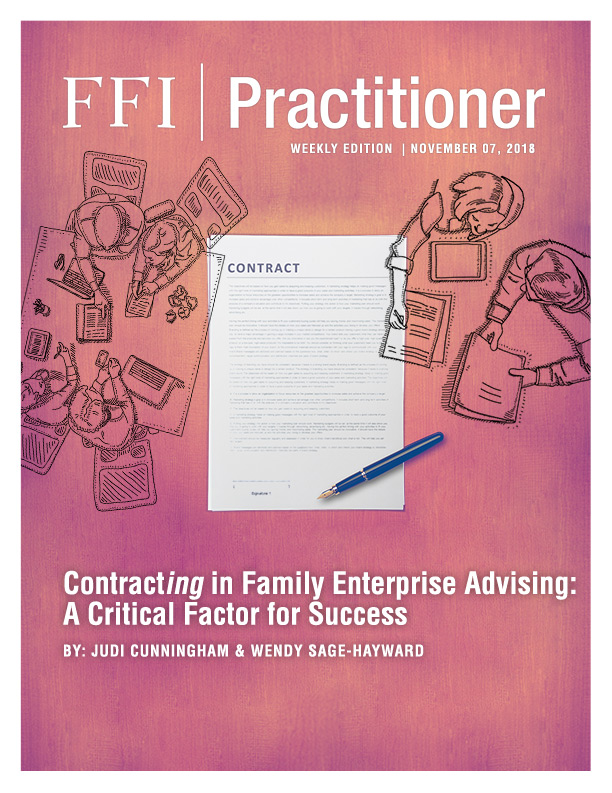Practice Insights
Contracting in Family Enterprise Advising: A Critical Factor for Success
Weekly Edition • November 07, 2018

From FFI Practitioner
This week’s FFI Practitioner addresses an often overlooked, but critical phase of the consulting process – contracting. Thank you to Judi Cunningham and Wendy Sage-Hayward for sharing this article that highlights the importance of contracting as an ongoing process, rather than a one-time discussion, and describes two levels of contracting that appear within an engagement.
A poorly executed contracting process leads to a host of challenges from simple misunderstandings to loss of the relationship and ongoing work. Many advisers fail to recognize the potential culprit as poor contracting, resulting in multiple types of challenges that may have been sidestepped with a better approach. We argue, in fact, that many, if not most, of the difficult issues arising in an advising engagement can be traced back to suboptimal contracting at the beginning or a failure to recontract regularly throughout the process.
“A poorly executed contracting process leads to a host of challenges from simple misunderstandings to loss of the relationship and ongoing work.”
What Contracting Is—and Isn’t
To understand what contracting is, it is important to start with what it’s not.
First, contracting is not just the contract itself—the written document that outlines the scope of work, financial arrangement, and other terms; although this can be an important objective or output. The goal of contracting is not just about telling the client what you or the team will do. Instead, it is an exploratory and negotiated exchange which frames key elements of the engagement and sets the stage for more effective outcomes. We believe it is best to view contracting as a process or journey, rather than a specific endpoint or destination. Contracting is also not just phase one of the engagement; it happens at the beginning and it also occurs throughout the engagement.

Why Contracting Matters
Any family enterprise adviser, including the authors of this article, have had things go wrong on client engagements—whether related to access, scope, boundaries, teamwork, finances, or other dimensions. The explanation, more often than not, is that the contracting process was suboptimal, omitting discussion of expectations on key dimensions. We believe contracting serves the following mutually reinforcing purposes:
Sidebar

by Wendy Sage-Hayward
- Alignment of perspectives and expectations: Everyone—you as the adviser, other advisers you may be working with, the client—has a different perspective and set of preferences. Contracting brings these into better alignment or at least creates strong awareness of differences, getting everyone on the same page with mutual understanding.
- Explains key terms: What’s the process for collaboration? Who will be involved? What outcomes are being aimed for? What deliverables will be produced? The easiest way to define terms of an engagement is to talk about them upfront, in detail. One family we know, for example, wanted to limit receipt of emails to business hours—that was critical to know at the outset. Contracting should cover as many terms as possible.
- Building trusting relationships: Contracting is where the advising team and client relationships begin. Alignment of perspectives and explication of key terms promotes trust and strong relationships from the beginning of an engagement. Effective contracting also sets boundaries and prevents unwelcome surprises. In one case, a family member thought he’d get to see plans related to succession before anyone else; the contracting process made clear these would be revealed to everyone in the family at the same time.
- Promotion of efficiency: Contracting saves time, money, and effort by establishing a truly common set of goals, terms, and understanding upfront and in later engagement stages as needed. This enables the main focus to remain the main focus, avoiding costly distraction, wrong assumptions, and backtracking.
Contracting is Ongoing
Even seemingly comprehensive contracting can’t account for everything encompassed by an engagement. If you accept that contracting is a process, it’s easy to understand that it will be an ongoing part of all projects with family enterprise clients.
It’s critical to engage in contracting upfront, as we’ve emphasized above, which means contracting will typically precede the processes of discovery, analysis and feedback, and implementation. But it usually doesn’t end there, nor should it. Contracting, at some level, continues through the entire engagement because it is challenging to cover all dimensions of an engagement at the outset due the complexity of the family enterprise environment; and things often change, requiring new discussion, consideration, and agreement.
We think of contracting as providing the bedrock on which advising takes place. A good contracting process lays the foundation upfront, but we often need to return to contracting to supplement and shore up that initial structure. It is not to say contracting will be a constant consideration but keeping an eye on evolving expectations and changes in a project is a good practice—and inevitably required in this complex landscape. Contracting informs and supports the engagement, and vice-versa.
“The goal of contracting is not just about telling the client what you or the team will do. Instead, it is an exploratory and negotiated exchange which frames key elements of the engagement and sets the stage for more effective outcomes.”
We propose that as advisers we consider contracting a flexible, fluid, ongoing process of clarifying roles, scope, goals, boundaries, and other key engagement components.
Two Levels of Contracting: Team and Client
Contracting is not just an ongoing process with the client. It’s also about negotiating the working relationship with your fellow advisers, with the client’s best interests—and your own—in mind. Below we discuss these two levels of contracting.

Family enterprise advising increasingly involves a team of advisers with different areas of focus and expertise. The team may include members from your own business or organization, such as a group of bankers or attorneys working with a family enterprise. Or it might be a team comprised of independent advisers including both technical (e.g., legal, accounting, insurance, etc.) and human resource oriented (e.g., therapists, business consultants, facilitators) or others—as assembled by the family or one of the advisers.
Regardless of the team’s composition, it’s critical to contract your way to alignment on key issues including:
- Who’s on the team? What is everyone’s role and responsibilities?
- What are the team’s individual and collective strengths?
- Who will lead and/or how will leadership function in our team?
- What are our main objectives, priorities, and deliverables?
- How will information be shared between us and with the family?
- How often will we meet/communicate with one another? With the client? In what configuration?
- How will we resolve disagreements?
- How will we address and resolve different fee structures among the different professions?
Aim to discuss these and other terms and consider formalizing your contracting conversations in the form of a multi/inter-disciplinary team charter which will help avoid ambiguity and promote a seamless, productive, and fulfilling collaboration. For example, one of us worked with another adviser on a family enterprise engagement with a tacit agreement that we would attend all key meetings together. But early on, the other adviser met with the client separately, resulting in some misalignment of knowledge and expectations. It also set up a climate of mistrust in the advisory team. Upfront contracting around core expectations would likely have prevented the tension that resulted from this situation.
Not surprisingly, even with some level of self-knowledge and team discussion, there can be unstated expectations that breed tension and, in some cases, resentment. Setting a team culture of talking through any issues that come up—and addressing these issues promptly is part of continuous, healthy contracting process at the team level.
In any engagement, level 1 contracting is often overlooked because of the strong bias and focus of attending to the client needs as primary.

Client-focused contracting offers a valuable opportunity to begin the client relationship most effectively and lay a foundation for longstanding trust and collaboration. Upfront and ongoing contracting with clients should focus on related areas including:
- Definition of client: Advisers and clients often make assumptions about who is primarily being served in an engagement — typically the founder or lead family member or members. Instead, we believe it is critical to discuss who will be served and whether this will change over time. Be willing to suggest expansion of who the client is as needed.
- Scope and deliverables: This can be a very challenging contract term, with multiple unspoken assumptions on all sides. Take the time to discuss in detail what work is expected in what time frame and stipulate how to address changes in these terms after the engagement begins.
“We propose that as advisers we consider contracting a flexible, fluid, ongoing process of clarifying roles, scope, goals, boundaries, and other key engagement components.”
- Process and cadence: How will the work be carried out and how quickly will the engagement progress? These simple questions encompass everything from meeting frequency to form of deliverables to knowing when the engagement is over. Go over these details carefully, as even the smallest matter can cause tension and conflict. This can also be an opportunity to explain what you do and don’t do as an adviser, and to elicit what resources the family is willing to invest in the process. One client thought at the beginning of the engagement that they wanted the work to progress at a rapid rate. As the engagement began, the realization by the client of the pressure on internal resources caused the client to ask to slow the process down. Often clients don’t know what they are embarking on, which is why recontracting is so critical.
- Compensation: The fee arrangement is sometimes an area of excessive or limited focus, but it’s always an important one. Make sure clients understand not just what you charge but also how you charge. Different advisory services have different structures for compensation. Encourage a discussion of all expectations around this dimension and ensure it encompasses all types of compensation structures for the team if applicable. For example, one of us had a client adamant about securing a discounted fee. Deeper discussion of the issue helped surface their concerns about budget, which led to a smaller project scope with fewer advisers involved and was amenable to all.
- Confidentiality and other boundaries: Boundaries relate to confidentiality, but also to time, access, work scope, and other dimensions. Be willing to bring these up, create clarity, and to aim for what’s in everyone’s best interests.
- Working style/preferences: Here again, many assumptions are made, and it’s critical to enquire about clients’ needs—whether preferences for meetings versus calls, hours of access, and others—while also keeping your own assumptions and preferences in mind.
In general, the more that can be discussed as part of the contracting process, the better. Unstated assumptions and expectations tend to be ubiquitous, as mentioned above. Ask questions and probe for more specific answers on all key dimensions. As you notice misaligned expectations, push for greater clarity, even if it is uncomfortable. Documenting what is agreed to helps ensure everyone heard the same thing and can be critical in the face of future disagreement. The ideal mentality is one of developing a collaborative partnership with the client, rather than doing something for the client. Good contracting promotes this perspective.
About the contributors

About Kennesaw State University
Kennesaw State University is a member of the University System of Georgia and the third-largest university in the state. The Cox Family Enterprise Center in the Coles College of Business acts as an intellectual and practical hub for the community of family members, non-family executives, external advisors, and students that it serves.

About The Family Business Consulting Group
The Family Business Consulting Group was co-founded in 1994 by Craig Aronoff and John Ward. It serves families and the enterprises that they have built by guiding them through the process of building structures, systems and skills for comprehensive strategy, better decision making, stronger competitive advantage, and continuity of enterprises for future generations.
Related Article
If you enjoyed this article, view the related article that discusses the comprehensive examination of an often utilized but seldom examined step of the consulting process, the engagement letter.


